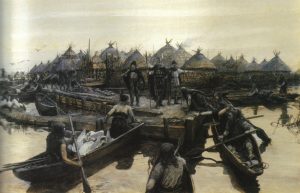 Glastonbury in 1397 is the setting for Joseph of Arimathea’s Treasure, the fifth novel in my Lady Apollonia West Country Mystery Series. There has been human habitation in the general area of Glastonbury for at least 75,000 years but not in the town itself. Wooden trackways were built in the Somerset Levels just to the west of Glastonbury from as early as 4000 BC. The tracks connected areas of higher ground, especially in times of high water due to flooding.
Glastonbury in 1397 is the setting for Joseph of Arimathea’s Treasure, the fifth novel in my Lady Apollonia West Country Mystery Series. There has been human habitation in the general area of Glastonbury for at least 75,000 years but not in the town itself. Wooden trackways were built in the Somerset Levels just to the west of Glastonbury from as early as 4000 BC. The tracks connected areas of higher ground, especially in times of high water due to flooding.
There were also marsh area Celtic settlements called lake villages which were built in the watery environment of the Somerset Levels on great platforms of felled timbers. One was just at the edge of present-day Glastonbury and another a couple of miles west near the village of Meare. The picture on the upper left is a 1911 reconstruction drawing by A. Forestier of the Glastonbury Lake Village showing log boats arriving laden with swans. This village reached its peak of about 200 people in the 2nd century BCE. Artefacts from the site are on display at the museum located in the Tribunal, a building on the High Street in Glastonbury.
There was trade for British tin from ancient Greece and Rome. Much of that was Cornish tin, but some of the tin came from the Mendip Hills in Somerset which form the north boundary of the Levels that I discussed I my last post. The trade in this tin could have been accessed by water just as it was with Cornish tin.
There are many interesting legends about Glastonbury, and I will discuss some of them in future postings including legends that concern Joseph of Arimathea, a New Testament character, coming to Glastonbury. Since he is part of the title of my novel, I would note here that if he came to Britain as the legends suggest, it would have been when the Celts were settled throughout Britain and before the Roman occupation. Furthermore, it would have been at a time when Glastonbury was accessible from the sea.
After 43 CE, the Romans treated the area of the Somerset Levels around Glastonbury as a rural area. However, the Fosse Way, the Roman road which connected Lincoln to Exeter passed just to the east of Glastonbury. There were Roman settlements in Bath and perhaps the towns of Wells to the northeast of Glastonbury and in Ilchester to the southwest. There is a cemetery just east of Glastonbury near Shepton Mallet that may contain Roman Christians.
For more on the Glastonbury Lake Village, click on
https://en.wikipedia.org/wiki/Glastonbury_Lake_Village .
For more on the Romans in Somerset, click on
http://www1.somerset.gov.uk/archives/ASH/Romano-brit.htm .
Tags: Chaucer's England, historical fiction, medieval mysteries